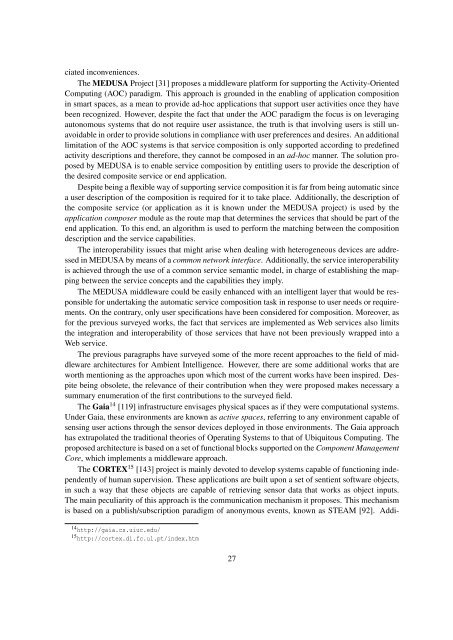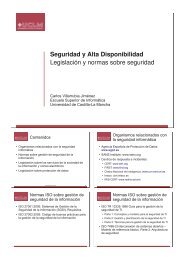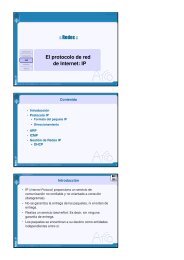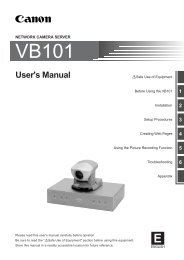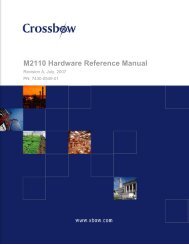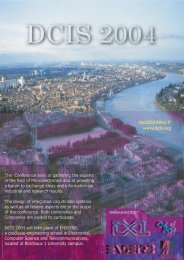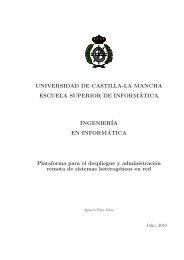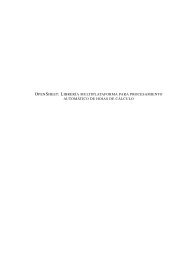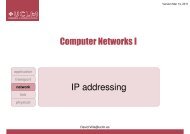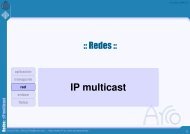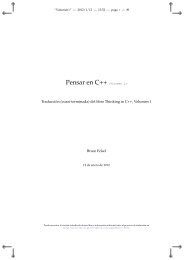MarÃa José Santofimia Romero - Grupo ARCO - Universidad de ...
MarÃa José Santofimia Romero - Grupo ARCO - Universidad de ...
MarÃa José Santofimia Romero - Grupo ARCO - Universidad de ...
Create successful ePaper yourself
Turn your PDF publications into a flip-book with our unique Google optimized e-Paper software.
ciated inconveniences.The MEDUSA Project [31] proposes a middleware platform for supporting the Activity-OrientedComputing (AOC) paradigm. This approach is groun<strong>de</strong>d in the enabling of application compositionin smart spaces, as a mean to provi<strong>de</strong> ad-hoc applications that support user activities once they havebeen recognized. However, <strong>de</strong>spite the fact that un<strong>de</strong>r the AOC paradigm the focus is on leveragingautonomous systems that do not require user assistance, the truth is that involving users is still unavoidablein or<strong>de</strong>r to provi<strong>de</strong> solutions in compliance with user preferences and <strong>de</strong>sires. An additionallimitation of the AOC systems is that service composition is only supported according to pre<strong>de</strong>finedactivity <strong>de</strong>scriptions and therefore, they cannot be composed in an ad-hoc manner. The solution proposedby MEDUSA is to enable service composition by entitling users to provi<strong>de</strong> the <strong>de</strong>scription ofthe <strong>de</strong>sired composite service or end application.Despite being a flexible way of supporting service composition it is far from being automatic sincea user <strong>de</strong>scription of the composition is required for it to take place. Additionally, the <strong>de</strong>scription ofthe composite service (or application as it is known un<strong>de</strong>r the MEDUSA project) is used by theapplication composer module as the route map that <strong>de</strong>termines the services that should be part of theend application. To this end, an algorithm is used to perform the matching between the composition<strong>de</strong>scription and the service capabilities.The interoperability issues that might arise when <strong>de</strong>aling with heterogeneous <strong>de</strong>vices are addressedin MEDUSA by means of a common network interface. Additionally, the service interoperabilityis achieved through the use of a common service semantic mo<strong>de</strong>l, in charge of establishing the mappingbetween the service concepts and the capabilities they imply.The MEDUSA middleware could be easily enhanced with an intelligent layer that would be responsiblefor un<strong>de</strong>rtaking the automatic service composition task in response to user needs or requirements.On the contrary, only user specifications have been consi<strong>de</strong>red for composition. Moreover, asfor the previous surveyed works, the fact that services are implemented as Web services also limitsthe integration and interoperability of those services that have not been previously wrapped into aWeb service.The previous paragraphs have surveyed some of the more recent approaches to the field of middlewarearchitectures for Ambient Intelligence. However, there are some additional works that areworth mentioning as the approaches upon which most of the current works have been inspired. Despitebeing obsolete, the relevance of their contribution when they were proposed makes necessary asummary enumeration of the first contributions to the surveyed field.The Gaia 14 [119] infrastructure envisages physical spaces as if they were computational systems.Un<strong>de</strong>r Gaia, these environments are known as active spaces, referring to any environment capable ofsensing user actions through the sensor <strong>de</strong>vices <strong>de</strong>ployed in those environments. The Gaia approachhas extrapolated the traditional theories of Operating Systems to that of Ubiquitous Computing. Theproposed architecture is based on a set of functional blocks supported on the Component ManagementCore, which implements a middleware approach.The CORTEX 15 [143] project is mainly <strong>de</strong>voted to <strong>de</strong>velop systems capable of functioning in<strong>de</strong>pen<strong>de</strong>ntlyof human supervision. These applications are built upon a set of sentient software objects,in such a way that these objects are capable of retrieving sensor data that works as object inputs.The main peculiarity of this approach is the communication mechanism it proposes. This mechanismis based on a publish/subscription paradigm of anonymous events, known as STEAM [92]. Addi-14 http://gaia.cs.uiuc.edu/15 http://cortex.di.fc.ul.pt/in<strong>de</strong>x.htm27


